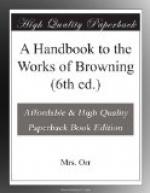It is farther stated that Franceschini showed the most intrepidity and cold blood of them all, and that he died with the name of Jesus on his lips. He wore the same clothes in which he had committed the crime: a close-fitting garment (juste-au-corps) of grey cloth, a loose black shirt (camiciuola), a goat’s hair cloak, a white hat, and a cotton cap.
The attempt made by him to defraud his accomplices, poor and helpless as they were, has been accepted by Mr. Browning as an indication of character which forbade any lenient interpretation of his previous acts. Pompilia, on the other hand, is absolved, by all the circumstances of her protracted death, from any doubt of her innocence which previous evidence might have raised. Ten different persons attest, not only her denial of any offence against her husband, but, what is of far more value, her Christian gentleness, and absolute maiden modesty, under the sufferings of her last days, and the medical treatment to which they subjected her. Among the witnesses are a doctor of theology (Abate Liberate Barberito), the apothecary and his assistant, and a number of monks or priests; the first and most circumstantial deposition being that of an Augustine, Fra Celestino Angelo di Sant’ Anna, and concluding with these words: “I do not say more, for fear of being taxed with partiality. I know well that God alone can examine the heart. But I know also that from the abundance of the heart the mouth speaks; and that my great St. Augustine says: ‘As the life was, so is its end.’”
It needed all the evidence in Pompilia’s favour to secure the full punishment of her murderer, strengthened, as he was, by social and ecclesiastical position, and by the acknowledged rights of marital jealousy. We find curious proof of the sympathies which might have prejudiced his wife’s cause, in the marginal notes appended to her depositions, and which repeatedly introduce them as lies.
“F. Lie concerning the arrival at Castelnuovo.”
“H. New lies to the effect that she did not receive the lover’s letters, and does not know how to write,” &c., &c.[25]
The significant question, “Whether and when a husband may kill his unfaithful wife,” was in the present case not thought to be finally answered, till an appeal had been made from the ecclesiastical tribunal to the Pope himself. It was Innocent XII. who virtually sentenced Count Franceschini and his four accomplices to death.
When Mr. Browning wrote “The Ring and the Book,” his mind was made up on the merits of the Franceschini case; and the unity of purpose which has impressed itself upon his work contributes largely to its power. But he also knew that contemporary opinion would be divided upon it; and he has given the divergent views it was certain to create, as constituting a part of its history. He reminds us that two sets of persons equally acquainted with the facts, equally free from any wish to distort them, might be led into opposite judgments through the mere action of some impalpable bias in one direction or the other, which third, more critical or more indifferent, would adopt a compromise between the two; and he closes his introductory chapter with a tribute to that mystery of human motive and character which so often renders more conclusive judgments impossible.




